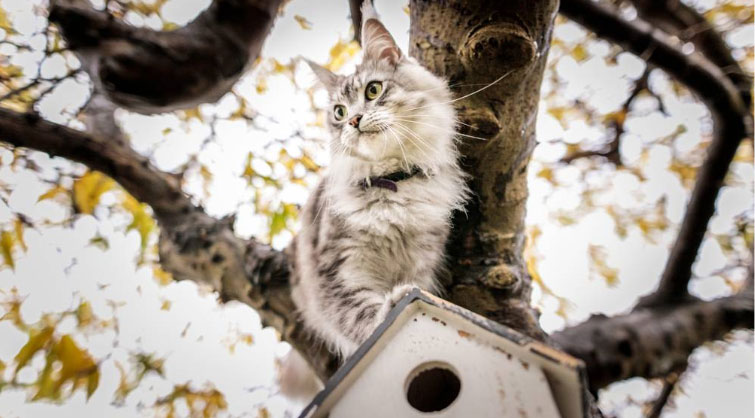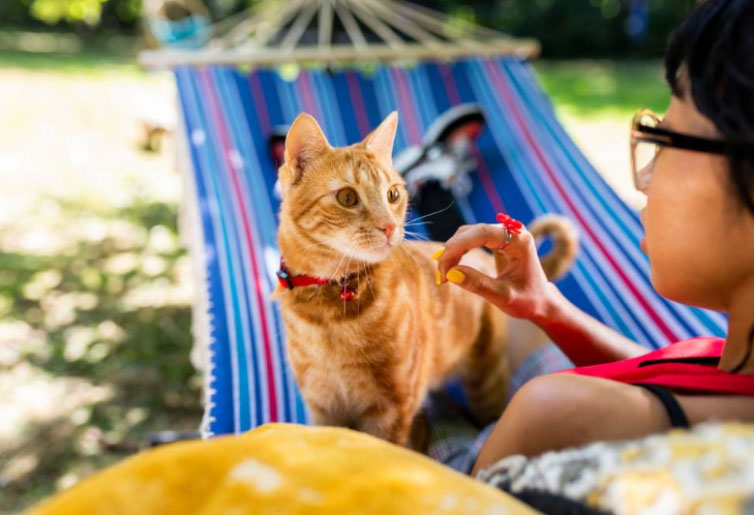Cat Training 101: A Quick Guide to Success
Train your cat to out trick your dog! Read on for a quick guide to cat training and making life easier and more convenient for the whole household.
CAT TIPS AND TRICKS

Posted by bravectosouthafrica – 10 February 2020
Yes, cats can be trained. Cat training has a triple-edged benefit. Firstly, it mentally stimulates and entertains your cat – ‘bye-bye’ boredom! Secondly, spending time, patiently training your feline friend strengthens your connection. Finally, it makes life easier for both of you. Plus, it can keep your cat fit!
The younger your cat, the better. Older cats tend to get set in their ways or work to preserve their energy with down time. However, all cats are trainable. But, before you begin, it’s crucial to commit to staying patient throughout the process. If you react in anger you’ll undo any progress you’ve made.
So want to teach your cat how to sit, stay or roll over? Then read on!

Before Starting Cat Training
Training a cat is easier when you understand your pet. Cats are very different from dogs: they aren’t as social, they are more independent, and they are tricky to motivate (except if you give them irresistible treats). Canines were bred to work with people while cats were trained to work behind the scenes, e.g. catching pests. This is why patience and creativity are prerequisites to cat training.
Patience may be hard at first, especially if you find that your cat is scratching your sofa, again. Cringe! Even so, the best thing to do with unwanted behaviours are to ignore them. Do not punish your cat. Ever.
Encourage, don’t punish. Why can’t you punish your cat? Quite simply, cats do not understand punishment and they won’t respond to scolding like dogs might.
During cat training stick to Hill’s Pets’ advice: “remember the three ‘R’s’ – respect, reinforcement and rewards.”
Respect your cat’s nature. If you hope to gain any ground in cat training, you need to be cat friendly, that is, sensitive to their likes and dislikes. Cats may dislike certain smells, while loud noises, sudden movements and car rides may be equally vile in their eyes.
Reinforcement refers to continual and consistent practice. Always praise the acts or behaviours you want your cat to repeat, and ignore those you want to discourage.

A few tips to keep in mind when training your cat:
Cats Don’t Understand Punishment
Punishing a cat could lead to extreme stress and spur behavioural problems – the exact opposite of what you want. Rather ignore or negate bad behaviour and praise and reward the good ones instead.
Take Enough Breaks
Training is exhausting, especially if you’re in the first stages of practice. Keep cat training short and sweet and always end with a treat or praise.
Training a cat is rather straightforward as you stick to a simple process of accustoming your cat to a new habit with the help of clicks and treats. Let’s get started with what you need.

1. Introduce Your Cat to the Activity
Some activities, behaviours or tricks will require some getting used to, especially if your cat has never tried them before. Be especially patient and attentive during nail clipping, bathing and litter box training.
Take baby steps. If you’re going to clip your cat’s nails, first let your cat get used to being touched on her paw. This will take time as their paws don’t get a lot of attention, and focussing on this area could be downright distasteful to your pet.
Initially, a few seconds is enough, but if your cat can endure a while longer, push their paw slightly so that their nails emerge. Soothe your kitty’s agitation with a treat and praise. If you go slowly and calmly, and you’re sure to be successful.

2. Use a Clicker or Make Special Sound
A clicker is a simple clicking tool used in training animals. You can use a pen with a click button, just ensure that the click it makes is clear and distinct. A clicker can speed up your cat training success. Once there is a desired behaviour, click and then offer your pet a treat to mark the action. With a clicker, you can also trick your cat into accepting a pill if they require it.
Random treats can confuse a cat or even seem suspicious. A command, followed by their action then a click and a reward will make more sense – yes, even to your cat! However, timing is everything. Make sure that you click the moment your cat does something right and follow up with a tasty treat. The sharp click signals the instant your furry friend behaves in the desired way and helps them to learn quickly.
Repetition is central to the success of cat training. Practice often and consistently until your cat masters the behaviour. You’ll find that your cat will lose interest after a few minutes. So, stick to a few minutes per session.

3. Praise & Positive Reinforcement
The beauty of the rewards in cat training is that you can teach your cat preferred behaviour through nearly no effort on your part. Simply praise your cat when they behave in the right way. For instance, if you want a vocal kitty, reward her meows with praise or a treat, and if you want a quiet cat merely ignore their vocalisations.
You must praise them the moment they do the right thing. Otherwise, they may associate praise with whatever followed. Additionally, reward consistently with the same type of treat.

4. Good Kitty Treats for Good Cat Training Sessions
Gently applauding your cat’s behaviour helps, but to really motivate your pet, you need to give them “good kitty” treats. Specifically, those they can’t resist. Food is your ally in cat training. Investigation coupled with perseverance will see you through to your end goal. Find out what your kitty loves most, and use it to your advantage.
Each cat has one or a few favourites. Anything from homemade snacks like cooked chicken, tuna or shop-bought treats could tickle their fancy. Try a few different options during cat training sessions on separate days to identify which your cat likes the most, then stick to it. Have you tried these tuna croutons? Download our DIY guide here.
Now, it comes to how to use the treat to your advantage.
- Schedule a time, preferably just before your cat’s mealtime when a training snack will prove most motivational.
- Once your cat does the preferred behaviour get ready to reward them.
- Make sure you have your cat’s attention.
- Hold the treat in your fingers and give it to them, without encouraging any alternative behaviours.
- Repeat until your cat gets the hang of it and has successfully learned the habit.
- Eventually, swop treats for praise or petting. You can gradually lessen the snacks and increase another form of reward. In time your kitty won’t need edibles to re-enact their trained behaviour.

3 Tricks to Teach Your Cat
Now, with the tools to successfully train Fluffy, you can explore the wide world of cat tricks and see which would suit your beloved ball of fluff. Here are three useful habits that will make life easier and more fun!
1. Come on Command
Yes, cats and dogs differ but kitties can also come to you if you call them. As one of the easiest habits to teach your cat, it’s a good idea to start with this one first. Call your pet’s name and reward them when they walk over to you – and don’t forget the click. Move on to another area in your home and repeat the process. Soon you won’t need treats to call them for meals.
2. Sitting for Feedings
Train a cat to sit down before a meal or even while they are walking. This is very useful if you need to tame the chaos of a multi-cat household. Get your cat’s attention with a tasty treat in your hand. Move it closer to their nose, as they sniff the treat, slowly move in an upward arc toward their ears. Take care not to lift your hand too high, unless you want to teach them to stand instead. They will sit as they start to look up. Once your cat sits down, praise them and repeat the process during another session.
3. Nail Clipping
Making a cat feel comfortable during a kitty pedicure is rarely possible on the first go. Luckily, you now have the basis and newfound patience (because you’ll need it) to conquer this discomfort. Remember to take small steps to inch toward the goal – nail clipping without a struggle or a scratch. Find the steps to fear-free nail clipping here.

Now it’s Time to Try Cat Training
There are many other fun things to teach your cat – walking on a leash, shaking hands and even ringing a mealtime bell! Your cat training adventure is whatever you make it, just remember to take your time, stay patient and be consistent.
You and your feline friends can enjoy training sessions together, free from any agitation caused by tiny pests. Keep flea, tick and mite infestations far from your home and pets with proactive pest control. Bravecto® for Cats is an easy to use solution that gets rid of ticks, fleas and ear mites. Effective treatment provides continuous protection for up to 3 months!
Subscribe to our Newsletter
Get to know your furry friend better! Sign up for all things dog- or cat-related.
The Hairy Facts about the dreaded hairball
12 April 2021
Help! My dog’s barking mad! Volume 2
12 April 2021
Your Itchy, Scratchy Cat – All About Cat Skin Problems
12 April 2021
The Dog’s Diet: A Bone of contention?
01 April 2021
Mango Fly Worms: How to Spot and Eliminate them
Posted on November 28,2019
Managing Mange And Mites In Your Dog
Posted on June 11,2018
Why Do Cats Purr and How? Learn What Your Cat Is Saying
Posted on October 14,2020
How to Get Rid of Ear Mites in Dogs
Posted on November 06,2019









